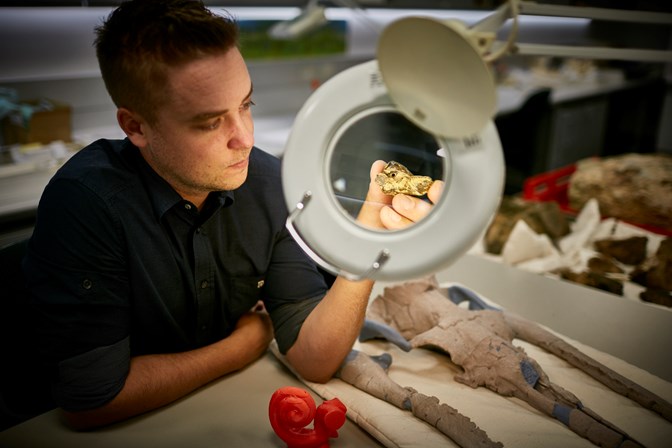New research finds baleen whales had extreme hearing prior to giant body size and filter-feeding
Baleen whales (mysticetes) are biological record breakers. They are the largest animals to have existed on Earth, reaching lengths of 30m.
They can consume four tonnes of krill a day using baleen (the hair-like structure that allows them to filter huge amounts of tiny prey from seawater) and they can also make and hear the lowest frequency sounds of any mammal.
How these extreme adaptations evolved is a mystery that still captivates scientists even today.
In a paper published today in the prestigious journal Proceedings of the Royal Society B a Melbourne-based group of scientists has found that baleen whales have had low-frequency sound during their entire evolutionary history.
For the first time, scientists have been able to determine what the earliest baleen whales could hear, a discovery made possible by detailing the anatomy of the inner ear, or cochlea, of baleen whales living between 23-34 million years ago.
Using fossil ear bones of early toothed mysticetes from the Museums Victoria collections, the team microCT scanned the bones, before constructing 3D digital models of the cochlea. They were then able to compare these models to those of today’s modern baleen whales and their fossil ancestors (a group known as the basilosaurids).
They discovered that the cochleae of these three groups are overall very similar, confirming that they’ve been able to hear low frequency sounds for millions of years, dating right back to their origin.
This is a fascinating discovery as the earliest baleen whales were radically different to the behemoths of today. They had teeth instead of baleen and were much smaller. At about three metres long they were roughly the same size as a dolphin – yet it has now been proven that they had a very similar hearing ability to baleen whales of today.
Low-frequency sound, or infrasonics, is sound that is lower in frequency than 20 hertz, the limit of human hearing. Yet baleen whales have been recorded making sounds as low as 12 hertz. It is likely the earliest baleen whales couldn’t quite hear such low notes but were very clearly low-frequency specialists.
But what were they listening to? Whale song is one of the most enigmatic sounds of the ocean. In fact, baleen whales produce the most complex songs in the animal kingdom. This ability to make and hear ultra-low frequencies allows them to communicate these long, eerily beautiful songs across tens and even hundreds of kilometres.
As Travis Park, Museums Victoria and Monash University said:
"This, at last, reveals that the earliest baleen whales heard low-frequency sound. The similarities of baleen whale cochleae to older whales shows us that this ability evolved well before other extreme adaptations such as baleen, filter feeding and gigantic body size. Although there’s no way of testing the idea, it’s tempting to think that mysticetes have been singing their complex, beautiful whale songs for millions of years."
This discovery has also proven that baleen whales have never had high-frequency hearing and could not echolocate (a sensory system used by certain animals to locate prey, navigate and sometimes communicate) like dolphins.
The team is now studying other aspects of baleen whale hearing that will provide exciting insights into its evolution.
As Travis Park hints, "the hearing of living baleen whales is not much better understood than that of their fossil relatives, so we can expect more surprises as we delve deeper into the history of whales’ most important sense."
The paper ‘Low-frequency hearing preceded the evolution of giant body size and filter feeding in baleen whales’ was written by Travis Park, Alistair Evans, Stephen Gallagher and Erich Fitzgerald.
This research was supported by an Australian Research Council Linkage Project grant to Alistair Evans and Erich Fitzgerald and an Australian Postgraduate Award to Travis Park.
Interviews with Travis Park, Museums Victoria and Monash University are available.
For interviews, a copy of the paper, high-res images and other queries please contact:

